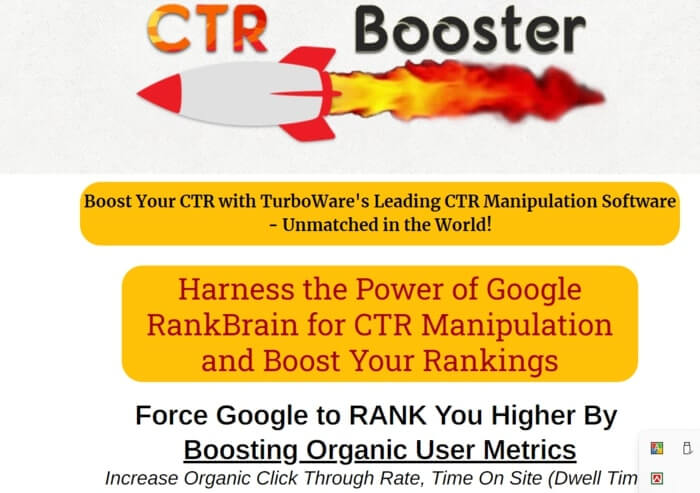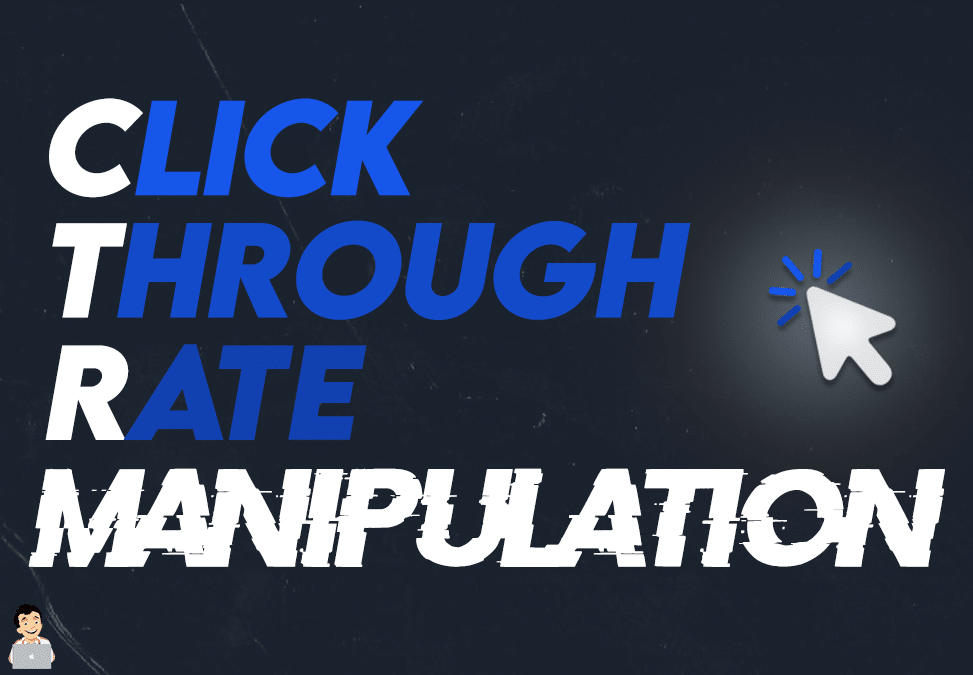The Ultimate Overview to Implementing Successful CTR Manipulation Tactics
The Ultimate Overview to Implementing Successful CTR Manipulation Tactics
Blog Article
Accomplishing Success With Targeted CTR Manipulation
The optimization of click-through rates (CTR) is a critical undertaking for brand names aiming to enhance their digital visibility and take full advantage of interaction. Targeted CTR control includes a series of strategies, from data-driven advertisement positionings to the advancement of compelling web content customized to particular target markets. Understanding the nuances of individual behavior and employing methods such as A/B testing can considerably affect efficiency outcomes. Nevertheless, the trip to grasping these tactics is intricate and needs a recurring commitment to evaluation and refinement. The question stays: what particular techniques will produce the most substantial lead to this vibrant landscape?
Comprehending Click-Through Rates
Click-through rates (CTR) work as an essential metric in digital advertising, mirroring the effectiveness of on the internet material in driving customer engagement. This metric is computed by separating the number of clicks a promotion or link gets by the total number of impressions, revealed as a portion (CTR Manipulation Press Release). A higher CTR indicates that the content resonates well with the target audience, prompting them to do something about it
Comprehending CTR is important for marketing experts intending to maximize their projects. Numerous variables affect CTR, consisting of advertisement positioning, layout, and the relevance of the content to the audience's interests. Engaging headings and aesthetically enticing photos can dramatically boost the possibility of individuals clicking on a web link.
Moreover, the context in which the content is provided plays an important duty in figuring out CTR. Ultimately, a detailed understanding of CTR equips marketers to fine-tune their approaches, making sure that electronic campaigns accomplish their desired results properly.
Importance of CTR Control
In the competitive landscape of digital advertising and marketing, the manipulation of click-through prices (CTR) has actually ended up being an essential technique for improving project performance. CTR acts as a vital performance sign, mirroring the effectiveness of on-line advertisements and material in bring in user interaction. A greater CTR not only signifies higher passion but additionally can bring about improved search engine rankings and lower cost-per-click (CPC) prices, therefore maximizing overall marketing budget plans.
The value of CTR adjustment hinges on its ability to notify marketing professionals concerning customer preferences and behaviors. By evaluating CTR information, services can recognize which components of their campaigns resonate most with their target market. This understanding permits even more enlightened decision-making and the allocation of sources to one of the most effective networks.
Moreover, effective CTR adjustment promotes a competitive benefit. Thus, understanding CTR control is not merely useful; it is important for achieving continual success in digital advertising and marketing efforts.
Techniques for Targeted CTR
Attaining targeted click-through rates (CTR) requires a calculated method that incorporates different techniques customized to particular audience sectors. One efficient strategy is enhancing ad positionings by utilizing information analytics to identify high-performing channels. By concentrating efforts on these channels, online marketers can improve visibility and boost involvement.
An additional crucial technique is crafting compelling headings and contacts us to action (CTAs) A/B testing different variations can expose which combinations resonate most with the target audience, therefore driving higher CTR. Additionally, incorporating aesthetic aspects such as attractive images or video clips can substantially enhance allure, making web content much more interesting and shareable.
Customization likewise plays an essential duty; utilizing individual data to produce customized material can promote a feeling of importance, motivating clicks. Leveraging social evidence through endorsements and user-generated content can develop depend on, inevitably boosting CTR.
Analyzing Individual Habits
 Understanding user behavior is crucial for enhancing advertising and marketing approaches and improving total performance. By evaluating exactly how customers engage with material, marketing professionals can obtain valuable understandings into preferences, inspirations, and pain factors. This expertise allows the development of more targeted campaigns that reverberate with particular audience segments.
Understanding user behavior is crucial for enhancing advertising and marketing approaches and improving total performance. By evaluating exactly how customers engage with material, marketing professionals can obtain valuable understandings into preferences, inspirations, and pain factors. This expertise allows the development of more targeted campaigns that reverberate with particular audience segments.To efficiently evaluate user behavior, various tools and methods can be employed. Internet analytics platforms offer information on user interaction metrics such as click-through rates, bounce rates, and time invested in web page. Heatmaps and session recordings enable marketing professionals to envision individual communications, exposing which aspects attract focus and which might be forgotten.
In addition, customer comments with studies and comments forms can offer qualitative insights, enhancing the understanding of user view and contentment. Segmenting users based on behaviors, rate of interests, and demographics can even more fine-tune targeting efforts, tailoring web content to fulfill varied requirements.
Ultimately, constant evaluation of user actions is important for adapting advertising and marketing strategies in real-time. As user fads progress, staying attuned to these why not try these out adjustments guarantees that campaigns continue to be pertinent and reliable, cultivating a much deeper connection with the target audience. This fundamental understanding sets the phase for the successful execution of targeted CTR adjustment techniques.
Determining Success and Readjusting Methods
Gauging success in targeted marketing projects requires a calculated technique that integrates performance metrics with continuous analysis. Trick efficiency signs (KPIs) such as click-through rates (CTR), conversion rates, and customer acquisition expenses have to be checked constantly to assess the performance of manipulation strategies. By establishing a standard, online marketers can assess changes in CTR and identify trends that indicate effective involvement or prospective shortcomings.
Regularly analyzing these metrics permits the prompt change of methods. If a certain campaign shows a considerable decline in CTR, it might signal the requirement for innovative alterations or a reevaluation of targeting parameters. Employing A/B testing can better improve approaches by comparing variations of ads or landing pages, site web supplying understanding right into what resonates finest with the target audience.
Furthermore, including qualitative feedback through surveys or user interviews can supplement quantitative data, providing an extensive view of audience understanding. Eventually, the capability to iteratively examine and improve methods based on real-time data promotes a more responsive advertising strategy, ensuring that projects continue to be aligned with service goals and Full Article target market preferences. This adaptive methodology is crucial in achieving continual success in targeted CTR adjustment.
Final Thought
To conclude, targeted CTR adjustment is vital for optimizing electronic advertising efforts. By recognizing click-through rates and utilizing calculated methods, brands can effectively improve user involvement and drive conversions. Constant evaluation of customer behavior and attentive measurement of efficiency signs assist in timely adjustments, making sure alignment with customer choices. Inevitably, effective CTR manipulation not just increases presence yet also cultivates count on and integrity, thus adding to continual growth in affordable markets.
 Targeted CTR adjustment includes a range of strategies, from data-driven advertisement positionings to the development of engaging material tailored to details audiences.Click-through rates (CTR) offer as a crucial metric in electronic advertising, mirroring the efficiency of online web content in driving individual involvement. A higher CTR indicates that the material resonates well with the target audience, triggering them to take action.
Targeted CTR adjustment includes a range of strategies, from data-driven advertisement positionings to the development of engaging material tailored to details audiences.Click-through rates (CTR) offer as a crucial metric in electronic advertising, mirroring the efficiency of online web content in driving individual involvement. A higher CTR indicates that the material resonates well with the target audience, triggering them to take action.CTR serves as an essential efficiency indication, reflecting the efficiency of on the internet promotions and content in bring in user involvement.In conclusion, targeted CTR adjustment is vital for maximizing digital advertising and marketing efforts.
Report this page